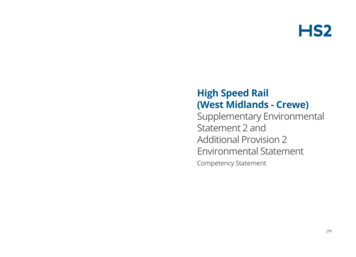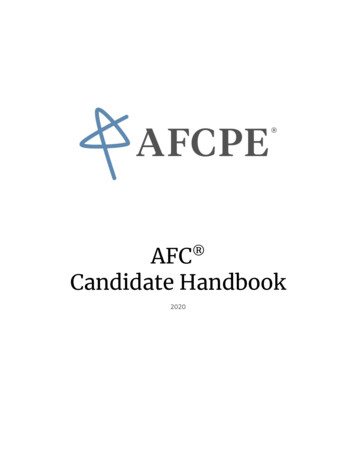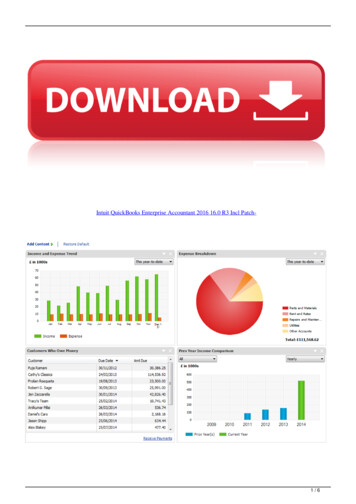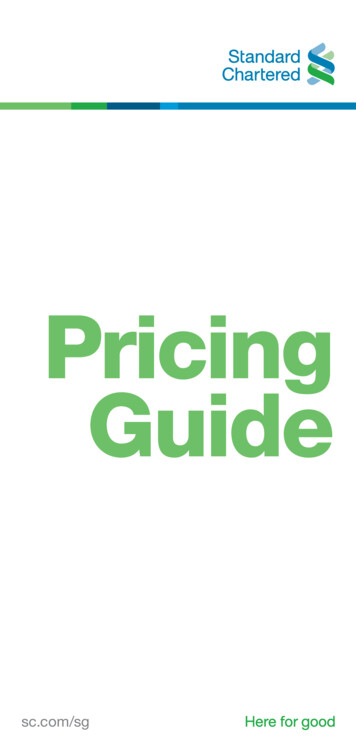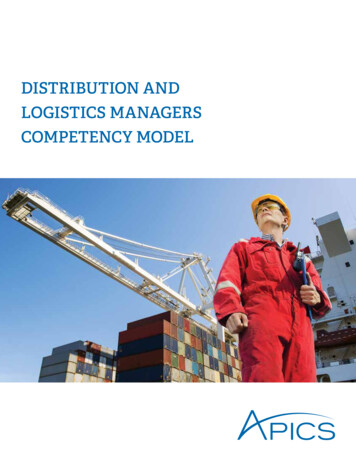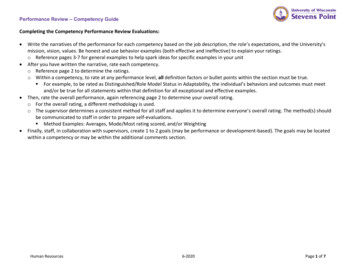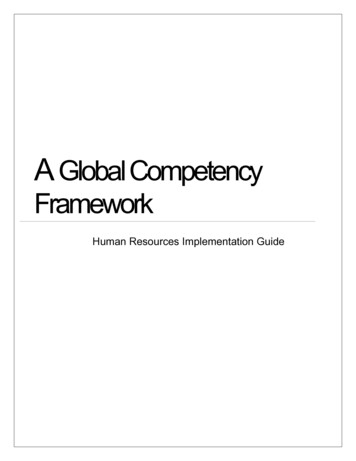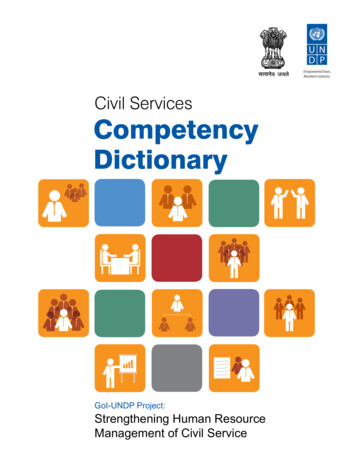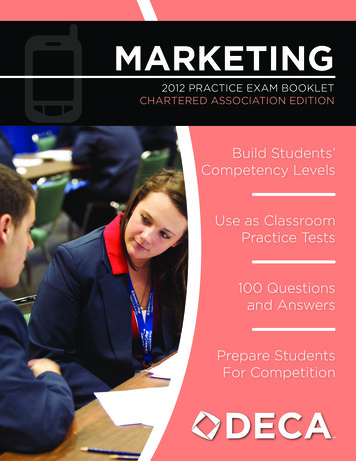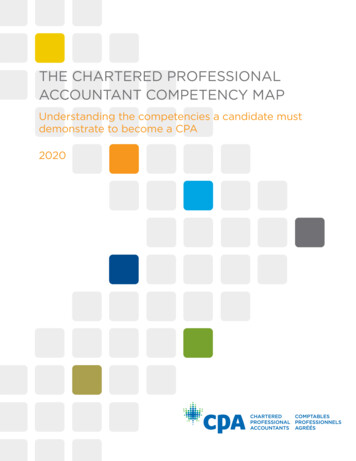
Transcription
THE CHARTERED PROFESSIONALACCOUNTANT COMPETENCY MAPUnderstanding the competencies a candidate mustdemonstrate to become a CPA2020
The Competency Map is used in all components of the CPA certification program.The effective dates for incorporating this Competency Map in each component areindicated below:CPA preparatory coursesJanuary 2021CPA Professional Education Program(CPA PEP)January 2021Practical Experience Requirements(CPA PER)January 2021Common Final ExaminationSeptember 2021Accredited CPA PEP courses/programsand recognized CPA prerequisitecoursesSeptember 2022If you have any specific questions about the operational implications of thisCompetency Map, please contact your regional/provincial CPA body or visit theCPA Canada website for more information.Library and Archives Canada Cataloguing in PublicationThe Chartered Professional Accountant Competency Map: Understandingthe competencies a candidate must demonstrate to become a CPAIssued in December 2019Issued also in French under the title:Grille de compétences des comptables professionnels agréés:Comprendre les compétences nécessaires à l’obtention du titre de CPAISBN 978-1-55385-727-3Copyright 2019iiThe Chartered Professional Accountant Competency MapUnderstanding the competencies a candidate must demonstrate to become a CPA
Contents1Introduction: Overview1CPA Certification: The Foundation for Accounting Careers in Canadaand Around the World1The CPA Competency Map and Its Stakeholders2The Information Contained in the CPA Competency Map3Section 1: Certification and the Professional Education Program4The Path to Certification4The CPA Certification Program5The CPA Professional Education Program (CPA PEP)7Section 2: Enabling Competencies, Technical Competencies,and Proficiency Levels8Their Interrelationship8The CPA Enabling Competencies9The CPA Technical Competencies10 Proficiency Levels11Section 3: The CPA Enabling Competencies17 Section 4: Reading the CPA Competency Map by Competency Area21 Section 5: The CPA Competency Map by Competency Area29 Section 6: Learning Outcomes by Module30 Exploring the Program Modules30 Reading the Modular View of the CPA Competency Map32 Entry Level Learning Outcomes42 Common Core Module 1 (C1) — Financial Accounting and Reporting52 Common Core Module 2 (C2) — Management Accounting, Planning,and Control62 Elective Module 1 (E1) — Performance Management68 Elective Module 2 (E2) — Finance73 Elective Module 3 (E3) — Assurance87 Elective Module 4 (E4) — Taxation90 The Capstone Modules of the CPA Certification Program90 Capstone Module 1 (Cap 1) — Integrative Module91 Capstone Module 2 (Cap 2) — Examination Preparation ModuleThe Chartered Professional Accountant Competency MapUnderstanding the competencies a candidate must demonstrate to become a CPAiii
93 Section 7: The Knowledge Lists and Examples94 The Knowledge Reference Lists95 Section 7-1: Financial Reporting100 Section 7-2: Strategy and Governance107 Section 7-3: Management Accounting117 Section 7-4: Audit and Assurance125 Section 7-5: Finance130 Section 7-6: Taxation137 Section 7-7: Data Analytics and Information Systems139 Section 7-8: Other General Business Topics144 Appendix A: Additional Information on Proficiency Levels154 Appendix B: Verb DefinitionsivThe Chartered Professional Accountant Competency MapUnderstanding the competencies a candidate must demonstrate to become a CPA
IntroductionOverviewCPA Certifcation: The Foundation for Accounting Careers in Canadaand Around the WorldThe Canadian Chartered Professional Accountant (CPA) certifcation programprovides the foundation on which to build a successful business career.The program is designed to meet the needs of public accounting, industry,and government by ensuring that all CPAs have a strong foundation of ethics,knowledge and skill to succeed and lead in any professional accounting role orposition. By preparing aspiring professional accountants for positions of leadership,trust and authority, it will enable them to pursue opportunities that suit their areasof interest, whether that be as an auditor, chief fnancial offcer, entrepreneur, orother positions where fnancial decision-making with integrity is essential.Vision for theThe Canadian CPA profession commits to meeting the standards as set out inCPA Professionthe International Accounting Education Standard Board’s (IAESB) Handbook ofThe Canadian CPAInternational Education Pronouncements. The standards focus on the professionalis the pre-eminent,globally respectedbusiness andaccountingknowledge, skills and professional values, ethics and attitudes which a professionalaccountant must demonstrate. The CPA certifcation program is in accordancewith the International Federation of Accountants (IFAC) standards for professionalaccountants. The program also prepares CPAs to embark on global careers throughreciprocal agreements with the world’s leading accounting organizations.designationThe CPA Competency Map and Its StakeholdersThe CPA Competency Map (or Competency Map) is the map for the CPAprofession. It profles the competencies required of a CPA on the path to, andupon, certifcation. The Competency Map will also form the basis for experiencerequirements which are set out in a separate document entitled CPA PracticalExperience Requirements.The Competency Map describes the competencies for all the elements of theCPA program. The Competency Map: helps guide candidates in understanding what is expected of them whenenrolled in the CPA professional education program; establishes the body of competencies developed through an integratedcertifcation process that includes education, evaluation and experience; provides guidance to post-secondary educators and program developers forthe further development of learning objectives for the professional educationprogram modules; and provides guidance to employers for the further development of competencyobjectives for practical experience (see the CPA Practical ExperienceRequirements).The Chartered Professional Accountant Competency MapUnderstanding the competencies a candidate must demonstrate to become a CPA1
The Information Contained in the CPA Competency MapThe Competency Map defnes the specifc competencies developed during theCPA certifcation program, including both the professional education programcomponent and practical experience component. However, the practicalexperience component is detailed in a separate document entitled CPA PracticalExperience Requirements.Section 1 provides an overview of the CPA certifcation program, of which theprofessional education program is one part.Section 2 describes the interrelationships among the CPA enabling competencies,the technical competencies, and the profciency levels expected for entry into theprofession. CPAs at the point of certifcation are not yet seasoned professionals.Therefore, profciency levels for CPAs at the point of certifcation are individuallyset for each competency. More information on how to interpret each of the threeprofciency levels and how they should be applied to certifcation is found inAppendix A. The defnitions of the verbs most frequently used in the competencydescriptions are found in Appendix B.Section 3 describes the seven areas of enabling competencies, those professionalskills that are essential to the CPA profession.The professional education program covers a wide spectrum of technicalcompetencies. To provide maximum guidance to both educators and candidates,the Competency Map provides two views of the CPA technical competencies inSections 4 and 5.Sections 4 and 5 present the technical competencies by the six technicalcompetency areas. This allows readers to distinguish those competenciesthat all CPAs must develop from those that are part of the elective modules.The competency area view also highlights the progression in development thatoccurs from the beginning to the end of the professional education program.Section 6 presents the CPA technical competencies by program module.The second view highlights the integration between the technical competencyareas, and contains more detailed learning outcomes for each competency.Section 7 describes how the profciency level defnitions apply to the knowledgecomponent of the competencies found in the CPA Competency Map at three keypoints: at entry to the CPA Professional Education Program (CPA PEP), in the coremodules, and in the elective modules. Its purpose is to help educators understandthe body of knowledge expected of candidates at each of these points, and how toapply the CPA Competency Map profciency levels to that body of knowledge.2The Chartered Professional Accountant Competency MapUnderstanding the competencies a candidate must demonstrate to become a CPA
SECTION 1Certifcation and the Professional Education Program
SECTION 1Certifcation and the Professional Education ProgramThe Path to Certifcation24 ractical counting Professional Education Program (PEP)Required forAdmission toProfessionalEducation Program Undergraduatedegree Specific subjectarea coverage1Core2Core1ElectiveCommon ModulesSix integrated technicalcompetency areas:Elective ModulesStudents chooseany two modules:1 Financial Reporting2 Strategy and Governance3 Management Accounting4 Audit and Assurance5 Finance6 Taxation 2ElectiveAssurancePerformance ManagementTaxFinancePublic AccountingStudents must: choose Assurance andTax for Audit or Reviewregistration contact provincial CPA bodyfor requirements for otherregistration types1IntegrativeModuleCapstone2 AcademicPrerequisitesExamPreparationCapstone tegrativeModule1 Students mustStudentsdemonstrate Breadth in allmust successfullysix technical competency areascomplete aprofession2 Students mustdeveloped Leadershipdemonstrate Depth in twocapstoneSkillstechnical competency areas:evaluation Professional Financial Reporting orpreparationSkillsManagement Accounting Integration of course in orderplusCompetenciesA to sit the fnal One from other technicalexamcompetency areasPublic Accounting Studentsmust demonstrate Depth in: Financial Reporting AssuranceThe CPA Certifcation ProgramThe CPA certifcation program comprises the following:Prerequisite Education: There are academic prerequisites for admission to the CPAcertifcation program. Before entering the program, candidates must complete anundergraduate degree and cover specifc subject areas. The specifc subject areasmay be covered during the undergraduate program, or through additional coursesoffered by universities, colleges, or various bridging programs.CPA Professional Education Program (CPA PEP): CPA candidates must completethe CPA Professional Education Program (CPA PEP), or its equivalent throughaccredited programs. It consists of a series of modules that develop professionalcompetence. Ethics and other enabling competencies, and prerequisite subjectmatter in areas such as IT, are integrated throughout the program.Practical Experience: Relevant practical experience enhances the educationcomponent of the CPA program. Completion of the professional educationprogram may run concurrently with the period of practical experience. A separatedocument, entitled the CPA Practical Experience Requirements, outlines how theCPA competencies apply to practical experience requirements.Common Final Examination (CFE): In addition to formative examinationsthroughout the program, the CPA certifcation program culminates in a summativefnal examination that evaluates candidates on the competencies defned by theCompetency Map.A CPA’s learning continues through post-qualifcation professional developmentcourses and specializations, as life-long learning is an important part ofthe profession.4The Chartered Professional Accountant Competency MapUnderstanding the competencies a candidate must demonstrate to become a CPA
Core Modules(C1 and C2)ElectiveModules(E1 to E4)CapstoneIntegrativeModule(Cap 1)SECTION 1The CPA Professional Education Program (CPA PEP)Capstone ExamPreparationModulen(Cap 2)The professional education component of the CPA program consists ofthe following:Core Modules (C1 and C2): There are two modules that are common to allcandidates. C1 focuses on fnancial accounting and reporting, and C2 focuseson management accounting, planning, and control. The main objective of thesecore modules is to build the enabling and the technical competencies requiredof a professional accountant. They are fully integrative. The core modules drawon the disciplines of law, economics, fnance, strategy, statistics, IT and others.They develop competence in incorporating and applying aspects of all areasof the competency map (i.e., fnancial reporting, strategy and governance,management accounting, audit and assurance, fnance, and taxation).The foundation of a CPA’s competences is formed while earning an undergraduatedegree and obtaining the coverage of specifc subject areas, and is then refnedand honed during the professional education program and the mandatory practicalexperience period.CPA candidates are expected to draw upon a body of knowledge covering certaintopic areas when demonstrating their professional competence. Some of thatknowledge will have been previously acquired, and some will be newly acquiredin the respective modules. Section 7 of this document outlines the general bodyof knowledge that supports the CPA Certifcation Program, and describes theexpected levels of profciency at the point of entry into the professional program,in the Core modules and in the Elective modules.Elective Modules (E1 to E4): After completion of the two mandatory core modules,candidates will choose two elective modules which allow them to explore a feldof their choice. Four elective modules will be offered, and candidates must choosetwo based on their interests and career aspirations:1*1. Performance management2. Finance3. Assurance4. Taxation*Some jurisdictions offer different levels of public accounting registration (audit, review, compilation, andothers). Candidates who plan to practise public accounting in the audit and review streams are requiredto take the Assurance and Taxation electives. Candidates who plan to seek registration for other licencesoffered in their jurisdiction should contact their provincial/regional CPA body for more information aboutthe electives that would be most appropriate.Certification and the Professional Education Program5
Capstone Integrative Module (Cap 1): This module is common to all CPASECTION 1candidates. Candidates learn about team management and how to communicatein a professional environment, and they deepen their strategic leadershipcompetencies using the knowledge they have acquired in the prerequisites andearlier modules.Capstone Examination Preparation Module (Cap 2): The fnal examinationpreparation module is common to all CPA candidates. The module focuses onpreparing candidates for entry into the profession by requiring them to applythe competencies they have acquired throughout the CPA program in complexand highly integrative cases. Candidates continue to develop their enablingcompetencies in situations which simulate real-life projects and assignments thatnewly certifed CPAs may encounter in their careers.In summary, the CPA program modules include:Core:C1— Financial Accounting and ReportingC2 — Management Accounting, Planning, and ControlElectives – Two of:E1 — Performance ManagementE2 — FinanceE3 — AssuranceE4 — TaxationCapstone:6Cap 1— Capstone Integrative ModuleCap 2— Capstone Exam Preparation ModuleThe Chartered Professional Accountant Competency MapUnderstanding the competencies a candidate must demonstrate to become a CPA
SECTION 2Enabling Competencies, Technical Competencies, and Profciency Levels
SECTION 2Enabling Competencies, Technical Competencies,and Profciency LevelsSEVEN ENABLING COMPETENCY AREASSIX TECHNICAL COMPETENCY AREAS1. Acting Ethically and Demonstrating1. Financial Reporting2. Strategy and GovernanceProfessional Values2. Leading3. Management Accounting3. Collaborating4. Audit and Assurance4. Managing Self5. Finance5. Adding Value6. Taxation6. Solving Problems and MakingDecisions7. CommunicatingTheir InterrelationshipSeven areasof enablingcompetencies Six areasof technicalcompetencies Expectedprofciency levelat point of entry CPA competencyupon enteringprofessionFigure 1: Competency Interrelationships — The CPA Competency Map separately presents,in the next sections, the enabling and technical competencies as well as the profciencylevels. However, to demonstrate competence, CPAs must connect the enabling and technicalcompetencies at the required profciency level.The CPA Enabling CompetenciesThe CPA enabling competencies provide the essential skills for ethical behaviour,leadership, teamwork, decision-making, problem-solving, and communicationas a professional accountant. The CPA candidate draws heavily upon the enablingcompetencies in demonstrating each of the specifc technical competencies.The enabling competencies are grouped into seven broad competency areas.1. Acting Ethically and Demonstrating Professional Values: The CPA professionis grounded in ethics, professionalism and protection of the public interest.CPAs have a duty to their profession and to society as well as to their individualand organizational interests. They do more than adhere to the CPA Code ofProfessional Conduct; CPAs ethical behaviour exemplifes and enhances thereputation of the profession. CPAs demonstrate integrity and trustworthiness,recognize ambiguity, ask insightful questions and work thoroughly and diligently.CPAs exhibit independence and objectivity to enhance the quality of their work.2. Leading: CPAs recognize and promote their strategic role within an organization.They focus on strategic priorities, participate in formulating and implementingstrategy, and drive performance management systems to monitor and improve8The Chartered Professional Accountant Competency MapUnderstanding the competencies a candidate must demonstrate to become a CPA
organizational outcomes. CPAs work closely with stakeholders throughout theSECTION 2organization to pursue common goals and achieve consensus. They contributeto the organizational culture, helping to embed cultural values and norms inbusiness and functional decisions.3. Collaborating: CPAs are respected and trusted, enabling them to partner withindividuals and teams throughout an organization. They draw on the strengthsand skills of diverse perspectives and develop and maintain valuable networkswith internal and external stakeholders. These competencies enable CPAs toparticipate in, build and lead goal- and value-oriented teams. They supporta collaborative and creative teamwork environment and maintain a crossfunctional and integrative outlook. CPAs use emotional intelligence to empathizewith others and to effectively manage and build relationships.4. Managing Self: Central to the CPA culture is a commitment to continuouslearning and professional development. CPAs exhibit adaptability, resilience andagility in an ever-changing business environment and assume accountability fortheir own performance. They recruit, coach, mentor, evaluate and inspire staff tocontribute to organizational success. CPAs also employ emotional intelligence toenhance their own and others’ performance.5. Adding Value: CPAs add value to their organizations, community and society.They collaborate effectively on cross-functional improvement projects.They identify areas that need improvement based on strategic priorities andoffer creative solutions. CPAs monitor improvement results and learn fromboth positive and negative experiences. They encourage a culture of mindfulco-operation, innovation, and sustainability.6. Solving Problems and Making Decisions: CPAs draw on strong problem-solvingand decision-making skills, including the ability to utilize technology and dataanalytics. CPAs capacity for analytical and integrative thought enables themto identify important issues, use evidence and analytics to thoroughly andobjectively evaluate alternatives, apply appropriate decision criteria, and developimplementation and change-management plans. CPAs consider relevant factorsthat others do not recognize.7. Communicating: CPAs ensure that their communications are effective whenspeaking, listening, presenting and writing in one of Canada’s two offciallanguages. They ensure that meaning is conveyed clearly and succinctly byattending to the needs of diverse audiences and selecting the most appropriatecommunication media. CPAs have the ability to tell the story of the businesswhen presenting information.The CPA Technical CompetenciesTechnical competencies refect the abilities expected of professional accountantsand performed by professional accountants in public practice, industry, the publicsector, and more.The CPA technical competencies are grouped into six areas.Enabling Competencies, Technical Competencies,and Proficiency Levels9
1. Financial Reporting: Includes the role of fnancial reporting, the application ofSECTION 2reporting frameworks, the reporting of routine and non-routine transactions indifferent circumstances, and an understanding of the role of internal control, tax,and fnance in fnancial reporting.2. Strategy and Governance: Includes the role of corporate governance within anorganization, as well as the formulation of strategies, the translation of thosestrategies into specifc business objectives and actions, and their implementation.3. Management Accounting: Includes identifying management information needsand developing the systems required to meet those needs; planning, forecasting,budgeting, cost and revenue management for an entity; and performancemeasurement systems.4. Audit and Assurance: Includes enhancing the reliability of information throughinternal activities such as internal control, internal and comprehensive auditing,and through external third party assurance services such as auditing.5. Finance: Includes fnancial analysis and planning, treasury management, capitalbudgeting, business valuation, and corporate fnance transactions.6. Taxation: Includes tax compliance and reporting, tax planning and implementationstrategies for both corporate and personal taxpayers, and an understanding of theadministrative processes in Canadian taxation.Profciency LevelsCPA candidates are expected to demonstrate competence at defned levelsof profciency. Three distinct and increasingly higher levels of profciency aredescribed, recognizing that candidates’ abilities increase throughout the program.Level C is the lowest profciency required, whereas Level A is the highest.Level C: To achieve competence at a C level, candidates must demonstrate retrievaland comprehension skills and be able to explain, describe, and demonstrateknowledge that is low to moderate in complexity for a routine situation.Level B: This level of profciency incorporates Level C profciency. To achievecompetence at a B level, candidates must be able to demonstrate knowledge, analyzeproblems, and draw logical conclusions in routine situations that have low to moderatecomplexity. Candidates must be able to perform a preliminary analysis of an issue, butthe work will require the involvement of more senior professionals to review the analysisor provide the necessary guidance before the candidates are able to complete the work.Level A: This level of profciency incorporates both Level C and Level B profciencies.To achieve competence at an A level, candidates must be able to demonstrateknowledge, analyze problems in suffcient depth and draw conclusions in routinesituations that have low to moderate complexity. In cases of non-routine andmoderate complexity, candidates are expected to be able to see some, but not all, ofthe interrelationships. In these situations, candidates will require some guidance froma more experienced professional to complete the task. [Highly complex and nonroutine situations are assumed to be handled by more seasoned professionals.]The terms complex and routine/non-routine are defned further in Appendix A.10The Chartered Professional Accountant Competency MapUnderstanding the competencies a candidate must demonstrate to become a CPA
SECTION 3The CPA Enabling Competencies
SECTION 3The CPA Enabling CompetenciesEnabling competencies reflect the personal attributes of being a CPA. A criticalaspect of enabling competencies is that they are pervasive to a CPA’s work andbehaviour. Enabling competencies allow a CPA to function as a competentprofessional in an increasingly complex and demanding environment. Enablingcompetencies also allow a CPA to develop skills that can be transferred acrossdifferent operating environments, different issues, and different roles. Possessionof these competencies enables the CPA to make successful use of the knowledgegained through their education, and to become a broad-minded professionalwho thinks logically, undertakes appropriate analysis, exercises good judgment,communicates effectively and acts to protect the public interest. The acquisitionof these competencies early in a CPA’s training begins the process of professionalgrowth and forms a strong foundation for life-long learning.CPA candidates are expected to draw upon the enabling competencieswhen demonstrating the technical competencies.1.Acting Ethically and Demonstrating Professional ValuesThe CPA profession is grounded in ethics, professionalism and protectionof the public interest. CPAs have a duty to their profession and to societyas well as to their individual and organizational interests. They do morethan adhere to the CPA Code of Professional Conduct; CPAs ethicalbehaviour exemplifies and enhances the reputation of the profession.CPAs demonstrate integrity and trustworthiness, recognize ambiguity,ask insightful questions and work thoroughly and diligently. CPAs exhibitindependence and objectivity to enhance the quality of their work.1.1 Ethical Behaviour1.1.1Acts ethically by adhering to the CPA Code of Professional Conduct1.1.2 Recognizes situations that could compromise ethical behaviour andseeks guidance1.1.3 Exhibits ethical behaviour by complying with laws and regulations,organizational policies, societal norms and personal ideals1.1.4 Reports unethical behaviour to an appropriate organizational levelor professional body1.2 Integrity and Trustworthiness1.2.1 Maintains confidentiality, dependability, fairness, honesty and privacywhen performing assigned work1.2.2 Seeks and responds to feedback on professional reputation1.2.3 Recognizes and manages potential breaches of confidentiality1.3 Questioning Mindset1.3.1 Maintains a skeptical mindset when performing assigned work1.3.2 Recognizes bias, uncertainty and ambiguity in the information andassumptions that underlie assigned work1.3.3 Investigates as necessary to clarify tasks and results andescalates appropriately12The Chartered Professional Accountant Competency MapUnderstanding the competencies a candidate must demonstrate to become a CPA
1.4 Due CareSECTION 31.4.1 Performs work carefully, thoroughly and competently in accordancewith relevant technical and professional standards1.4.2 Critically reviews own work to ensure its quality1.5 Objectivity1.5.1 Recognizes and avoids potential conflicts of interest1.5.2 Performs assigned work with an independent state of mind to minimizebias and undue influence2. LeadingCPAs recognize and promote their strategic role within an organization.They focus on strategic priorities, participate in formulating andimplementing strategy, and drive performance management systems tomonitor and improve organizational outcomes. CPAs work closely withstakeholders throughout the organization to pursue common goals andachieve consensus. They contribute to the organizational culture, helping toembed cultural values and norms in business and functional decisions.2.1 Strategic focus2.1.1 Applies knowledge of the organization’s competitive environment andstrategic direction when performing assigned work2.1.2 Assists managers and works on teams to support business- andfunctional-level strategy planning, implementation or monitoring2.1.3 Identifies the strategic impact of internal decisions and external influenceson project plans and initiatives2.2 Risk management2.2.1 Assists in identifying and monitoring risks within areas of workresponsibility2.2.2 Recognizes the importance of internal controls within areas of workresponsibility2.3 Organizational culture advocacy2.3.1 Aligns behaviour with workplace norms, while complying withprofessional ethics and values2.3.2 Recognizes the importance of organizational culture2.4 Influence and consensus building2.4.1 Promotes and gains support for ideas within areas of work responsibility2.4.2 Refers to internal policies and procedures and obtains input about how tohandle disagreementThe CPA Enabling Competencies13
3. CollaboratingSECTION 3CPAs are respected and trusted, enabling them to partner with individualsand teams throughout an organization. They draw on the strengths andskills of diverse perspectives and develop and maintain valuable networkswith internal and external stakeholders. These competencies enable CPAs toparticipate in, build and lead goal- and value-oriented teams. They supporta collaborative and creative teamwork environment and maintain a crossfunctional and integrative outlook. CPAs use emotional intelligence toempathize with others and to effectively manage and build relationships.3.1 Inclusivity3.1.1 Respects and values diversity3.2 Teamwork3.2.1 Participates in teams related to work functions3.2.2 Evaluates performance of team members3.2.3 Seeks guidance from team leaders and other team members3.2.4 Commits to team goals3.2.5 Shares kno
The CPA Competency Map (or Competency Map) is the map for the CPA profession. It profles the competencies required of a CPA on the path to, and upon, certifcation. The Competency Map will also form the basis for experience requirements which are set out in a separate document entitled

